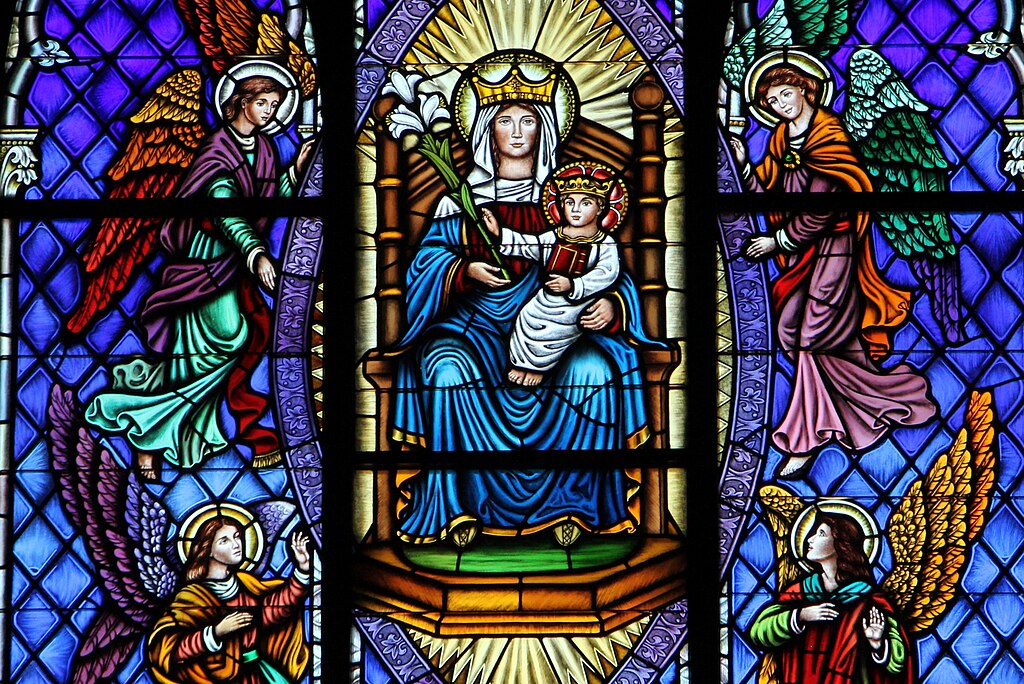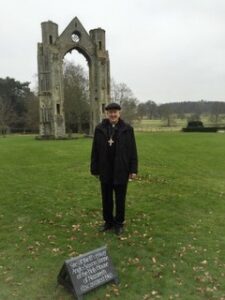
Stained glass of Our Lady of Walsingham, Houston, TX. Image Credit: Fr James Bradley from Southampton, UK, CC BY 2.0, via Wikimedia Commons
*****
For those who may be interested in exploring Catholic holy sites in the United Kingdom, I always suggest putting the Shrine of Our Lady of Walsingham at the head of the list. It’s about 120 miles north-northeast of London, in a rural area of East Anglia near the North Sea coast. It is not a simple journey, even with today’s transport options. That encourages us to reflect on the steadfast resolve of pilgrims in the Middle Ages who made this the principal Marian pilgrimage site in northern Europe.
In 1061, Richeldis de Faverches, lady of the manor of Walsingham, had three visions in which the Blessed Virgin appeared to her; she took her to Nazareth, to the house where the Archangel Gabriel had visited her at the Annunciation. Mary then asked Richeldis to build an exact replica of the holy house in Walsingham. “All that seek me there will find help in need,” she promised (according to the 15th century “Pynson Ballad”). Walsingham would soon become an important place of pilgrimage, supported by the establishment of the Augustinian Priory of the Annunciation of the Blessed Virgin Mary in 1153. Many English kings made pilgrimages; King Henry III made a dozen visits. The young Henry VIII is reported to have made a pilgrimage in about 1510, perhaps to have asked for the Blessed Mother to give him and his first wife, Catherine of Aragon, a son. Their son Henry was born on January 1, 1511, but died only seven weeks later.
Henry VIII had been raised a faithful Catholic, but perhaps this experience had something to do with his decision to abandon the Church. He had not learned the key to prayer: “not my will but thine be done” (Luke 22:42). In 1538, the Shrine at Walsingham was torn down by his imperial edict, and the famed statue of Our Lady of Walsingham was taken to London and destroyed.
Even the great scholar Erasmus, while he was teaching at Cambridge, made a pilgrimage to Walsingham in 1511. He was moved by the elegant simplicity of the Holy House and the statue of the Blessed Virgin Mary, but he would later speak satirically about the intensely pious and enthusiastic devotions of the pilgrims.
Converts sometimes have difficulty understanding the popular Marian devotions they encounter in the Catholic Church. I personally found the dogmatic definitions (Immaculate Conception, Assumption) easier to receive, simply by reflecting on Paragraph 487 of the Catechism: “What the Catholic Faith believes about Mary is based on what it believes about Christ, and what it teaches about Mary illumines in turn its faith in Christ.”
But what about all those Marian apparitions and devotions? Shouldn’t that be tempered by Scripture? Mary simply says,
“Do whatever he tells you” (John 2:5). The Holy See has found it a great challenge to judge the legitimacy of such apparitions, but the shared experience of the faithful has always been an important criterion. The Church teaches that we are not required
to accept private revelations which go beyond the apostolic deposit of faith (CCC 67). But think of when we see children so deeply in love with their mother that they gush forth with praise for her: it is their love which we remember most.

Msgr. Jeffrey Steenson in Walsingham, February 2015.
In 2015, I had the great privilege of making a pilgrimage to Walsingham with my two colleagues, the Ordinaries of the Ordinariates of Our Lady of Walsingham (UK) and Our Lady of the Southern Cross (Australia). We were so moved by the ecumenical cooperation between the Catholic and Anglican shrine churches and seeing so many pilgrims at prayer. The restoration of this holy place had begun in the late 19th century, and it has grown to be a major pilgrimage site with some quarter million visitors annually. What good fortune that on the surviving original seal of the Augustinian priory was found an image of the original statue of Our Lady of Walsingham. This was used to reproduce the beautiful statue so beloved today of Mary, the Seat of Wisdom, on whose lap sits the Son of God.
If a trip to England is not feasible, one could visit the wonderful outdoor shrine and the holy house chapel at the Cathedral of Our Lady of Walsingham in Houston, TX. Here is where the Ordinariate of the Chair of St. Peter was first established in 2011. But the foundations were laid in the parish’s Anglican days, a fitting testimony to those wise words from Vatican II’s Lumen Gentium 8, about those elements of sanctification and truth which lead toward Catholic unity.
*****
PRAYER FOR THE FEAST OF OUR LADY OF WALSINGHAM
Grant, we pray thee, O Lord God, that as in the mystery of the Incarnation the blessed
and ever-Virgin Mary conceived thy Son in her heart before she conceived him in her womb: so
we, thy pilgrim people, rejoicing in her patronage, may welcome him into our hearts; and, like her,
be made a holy house fit for his eternal dwelling; who liveth and reigneth with thee, in the unity
of the Holy Spirit, ever one God, world without end. Amen.
(Divine Worship: The Missal, Sept. 24).






